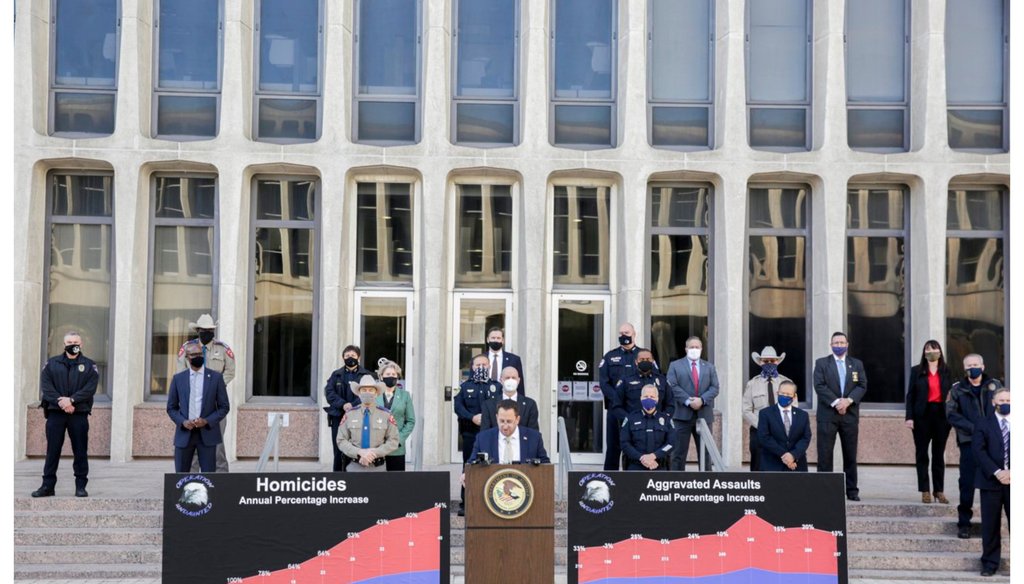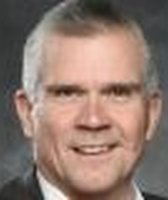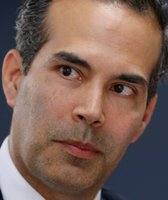Stand up for the facts!
Our only agenda is to publish the truth so you can be an informed participant in democracy.
We need your help.
I would like to contribute

United States Attorney Gregg N. Sofer speaks to member of the press during a conference introducing the crime prevention program, Operation Undaunted, outside of the U.S. Attorney's Office on Friday, Dec. 18.
U.S. Attorney Gregg Sofer is the latest official to link rising crime rates in Austin with the Austin City Council’s recent decision to cut police funding.
On Dec. 18, Sofer stood at a podium before Austin’s press corps to announce that his office will be joining state efforts to combat violent crime in the capital — an initiative called Operation Undaunted. Sofer stood flanked by two large cardboard cutouts with charts that compared the city’s homicide and aggravated assault rates in 2020 to those in 2019.
Through the first 10 months of this year, the city’s homicide rate was up by 54% compared to the first 10 months of 2019 — from 26 last year to 40 in 2020. Aggravated assaults were up by 19% as of October, from 2,200 in 2019 to 2,620 this year. Austin is one of several cities across the U.S. that has recorded sharp increases in homicides since the beginning of the pandemic.
"Violent crime is skyrocketing in the Austin area," Sofer said. "The murder rate, which is the most reliable of all crime statistics, shows that murder is up over 50% in this city just so far this year. When you defund police, when you lax enforcement of existing criminal law, when you release repeat offenders and violent criminals into our streets, this is exactly what you can expect."
The Austin City Council’s August decision to cut $21.5 million from the Police Department’s budget and shift another $128 million to other city departments has attracted a flurry of criticism from Texas leaders. Gov. Greg Abbott has tied increases in certain crime categories to police defunding, saying at one point that "residents are left to fend for themselves." He has proposed a state takeover of the Police Department.
Sign up for PolitiFact texts
In October, the Texas Freedom Caucus, a conservative group of legislators, released a video saying that Austin’s "crime is up because police funding is down." Later that month Lt. Gov. Dan Patrick falsely stated that Austin is "now one of the most dangerous cities in America and definitely in Texas" due to police defunding.
Sofer, who was appointed by President Donald Trump in October, is the first federal official to take action on Austin’s "skyrocketing" violent crime.
The national crime picture
In September, the FBI released crime statistics for the first six months of the year that showed a nationwide decline in the number of violent crimes overall. The only two categories of violent crime that had increased over 2019 levels were murder (up 15%) and aggravated assault (up 5%), the same categories Sofer highlighted in Austin.
Crime analyst Jeff Asher, co-founder of the consulting firm AH Datalytics, recently published findings in The New York Times that found Austin saw the 19th highest increase in murder rate this year among the largest U.S. cities. Two other Texas cities cracked the top 20 list, too.
Lubbock had the third-highest increase in murder rate through the first half of 2020, with murders doubling from 15 last year to 30 this year. Fort Worth ranked 13th, with a 65% increase in murders. Both cities increased police funding this year.
Other larger Texas cities posted big increases as well. Houston recorded a 42% increase in murders from 2019 to 2020, and San Antonio recorded a 25% increase. Both of these cities also boosted police funding this year.
So why the focus on Austin? In a Dec. 22 interview, Sofer said his power is limited to the boundaries of the Western District of Texas, which includes Austin, San Antonio, Waco, Del Rio, Midland-Odessa and El Paso.
He said his office plans to roll out a program similar to Operation Undaunted in San Antonio next, although he did not give details.
"We've been planning to roll it out in Austin and San Antonio for some time," he said. "I happen to live in Austin, I happen to be based in Austin most of the time, and we had started the plans here. But as I said, we planned to roll this out elsewhere and we did not pick Austin for any particular reason — although the numbers in Austin are pretty stark, they're very concerning. I think they'll be concerning in other cities as well."
Violent crime rate and Austin police defunding
Austin police officials have said this year’s high number of murders is not attributable to changes in the city’s police budget, which went into effect Oct. 1.
Austin police Lt. Jeff Greenwalt, who works in the homicide and aggravated assault units, said last month that the department saw a rise in violent crime in the early months of 2020, before discussions of police defunding materialized last summer.
Greenwalt also told PolitiFact in August, after Abbott underscored Austin’s jump in murders, that percentage increase statistics can seem more alarming than they are in reality.
"While there is an increase, it is only a handful more because we have low numbers in the first place," he said.
And Carsten Andresen, a criminologist at St. Edward's University, said that it’s inadvisable to use percent change statistics to represent changes in smaller numbers.
"I’ve always been told: don’t use percentages for numbers that are under 50. If you’re looking at 30 or 45, don’t use a percentage difference because the percentage changes are so big," Andresen said.
But Sofer focused on Austin’s percent change figures.
"You don’t want to live in a city in which the murder rate is going up by 50%," Sofer said in an interview. "The numbers in Austin are relatively low, we’re lucky that way. But that’s not the point. The point is, when murder is up 50% it’s a significant problem for your community."
Furthermore, Sofer considers a city’s murder rate "the most reliable of all crime statistics," meaning that it is the most serious form of violent crime and is a category of crime that is most likely to get reported.
On that point, criminologists agree: some offenses are more likely to be reported to police than others, specifically homicides and car thefts. Car theft is reliably reported to police because police reports are necessary for filing claims with insurance companies; homicides are reliably reported because those crimes typically leave lots of evidence, in particular a dead body.
But that’s where their agreement ends. A higher murder rate is not evidence of a general upward swing in crime. In fact, violent crime overall in Austin — which include offenses like kidnapping, assault, rape and manslaughter — is down by 1% this year compared to last.
"Because [murders] are rare to begin with, short-term changes can loom large when they are ultimately not terribly meaningful," said Texas State University criminologist Sean Roche. "In this sense, homicide is not necessarily reliable in forecasting the future."
Criminologists also disagree that increases in the city’s 2020 murder rate or aggravated assault rate are a direct result of police budget cuts, which occurred 10 months into the year. Rather, crime trends are less a result of specific policy decisions than macro-level drivers, like unemployment rates, a population’s alcohol and drug use, prevalence of firearms and age structure.
"If homicide rates are truly trending upward, we would have to eliminate (either logically or statistically) all other potential causes of this increase before we could definitively conclude it was a result of changes in the funding or enforcement actions of Austin PD," Roche said. "Considering the many momentous events we have endured this year, I am skeptical that has been done."
Sofer attributed the increased murder and aggravated assault rate to two additional things in addition to police funding: the release of "repeat offenders and violent criminals into our streets," and "lax enforcement of existing criminal law."
When asked what Sofer was referring to when he said that "lax enforcement of existing criminal law" contributes to Austin’s violent crime rate, his office only said that Operation Undaunted would target those who "re-offend after being released on bond, or who continually commit acts of domestic violence and present an ongoing danger to victims." Under Operation Undaunted, his office will work with local district attorney's office and law enforcement agencies to federally prosecute repeat offenders.
Our Sources
Austin American-Statesman, Federal authorities' vow to cut violent crime in Austin strong on words but thin on details, Dec. 18, 2020
PolitiFact Texas, Examining claim about Austin homicides, crimes, Aug. 31, 2020
PolitiFact Texas, Examining Austin's property crime trends, Oct. 9, 2020
PolitiFact, No, Austin is not one of the most dangerous cities in Texas, let alone in the U.S., Nov. 6, 2020
Tweet, Oct. 5, 2020
Austin American-Statesman, Austin homicides hit 20-year high; rise not linked to police funding, police say, Nov. 9, 2020
Interview, U.S. Attorney Gregg Sofer, Dec. 22, 2020
Emails with Texas State criminologist Sean Roche, Dec. 22, 2020
Emails with St. Edward's University criminologist Carsten Andresen, Dec. 22, 2020
New York Times, Police Pin a Rise in Murders on an Unusual Suspect: Covid, Oct. 29, 2020
Austin Police Department, Chief’s Monthly Report, Nov. 2020
New York Times, Murders Are Rising. Blaming a Party Doesn’t Add Up, Sept, 28, 2020
FBI, Overview of Preliminary Uniform Crime Report, January–June, 2020, Sept. 15, 2020













































